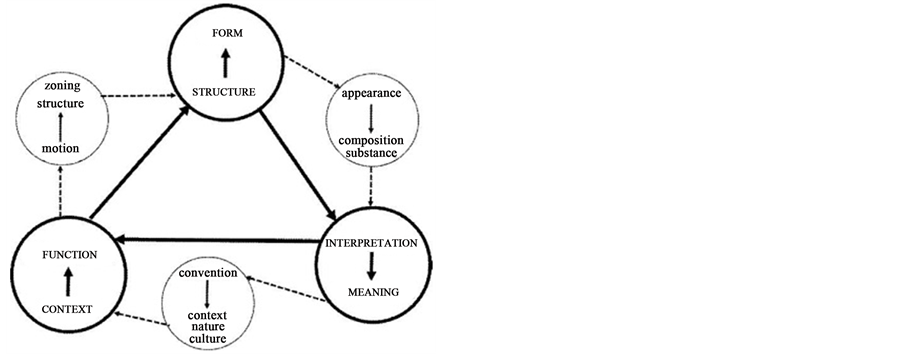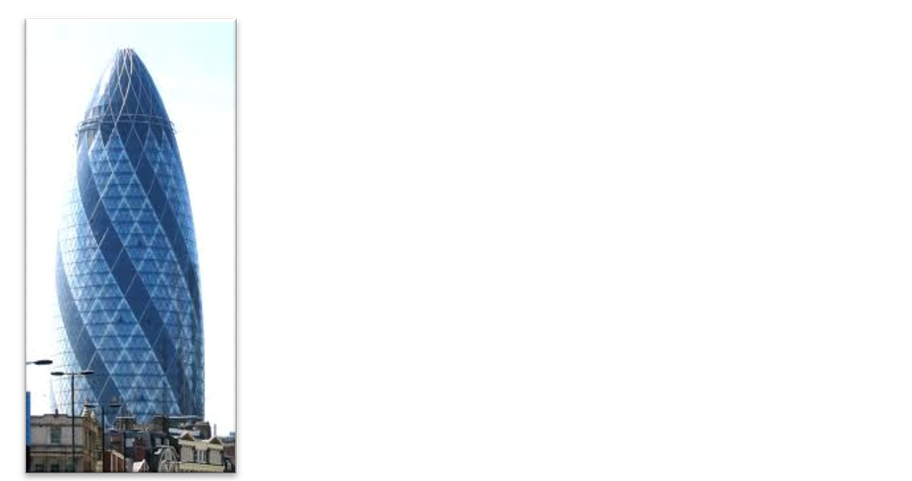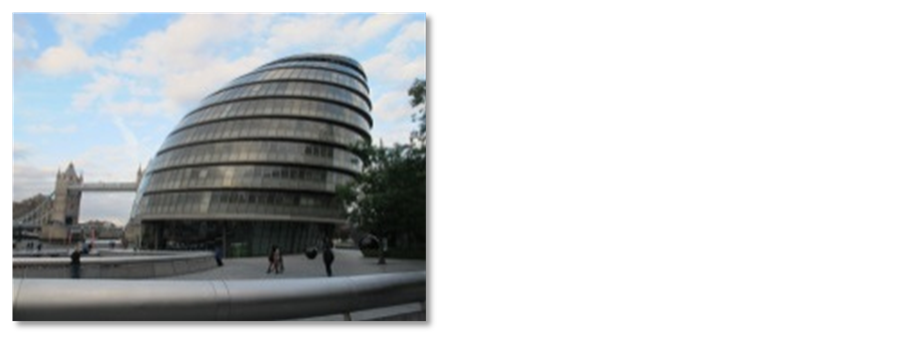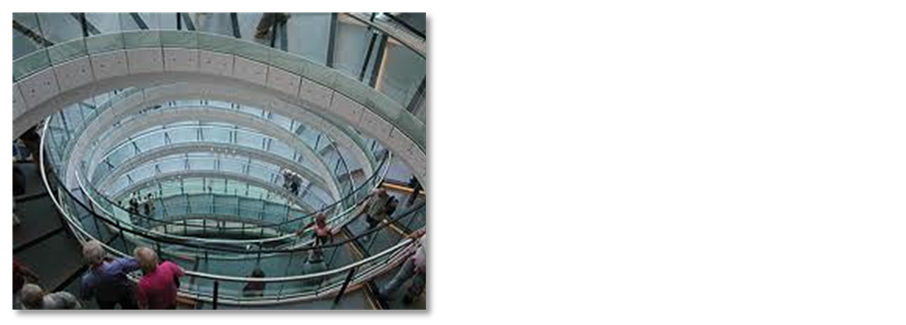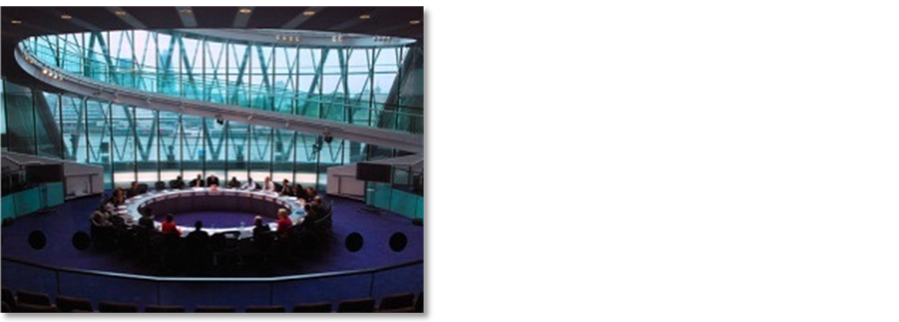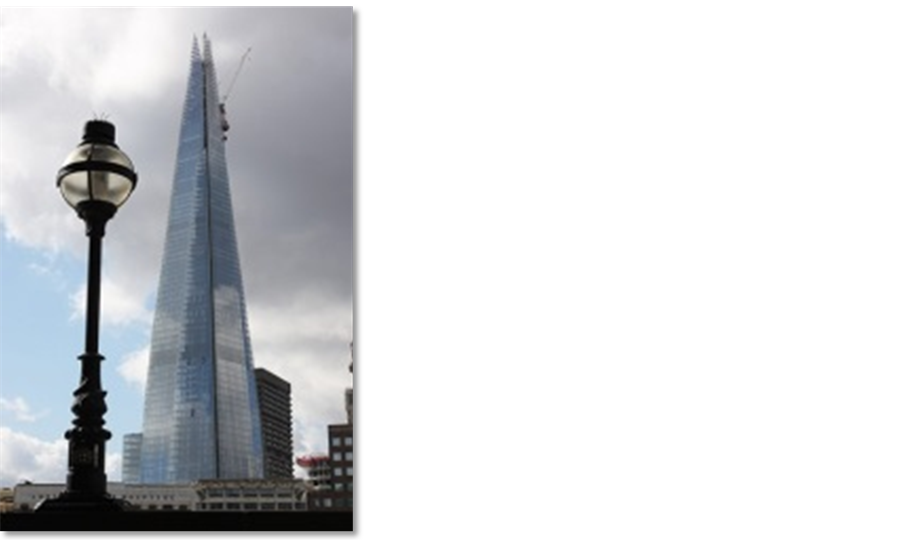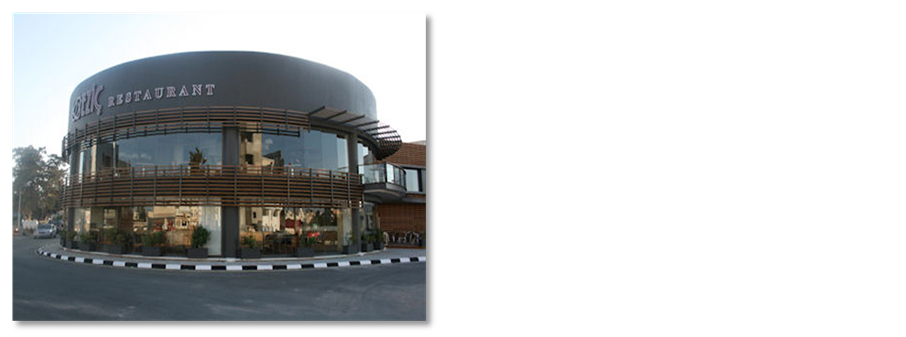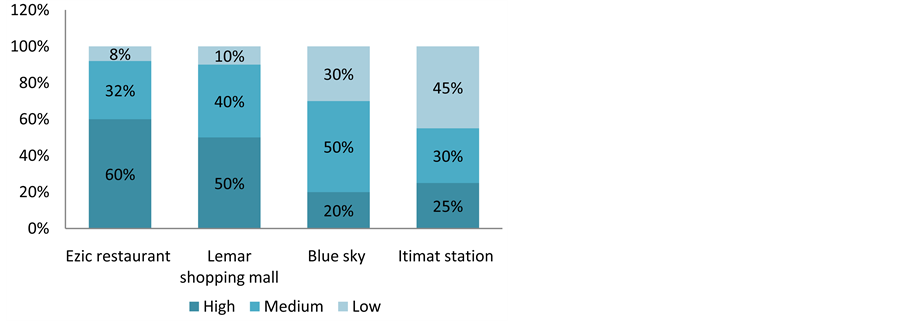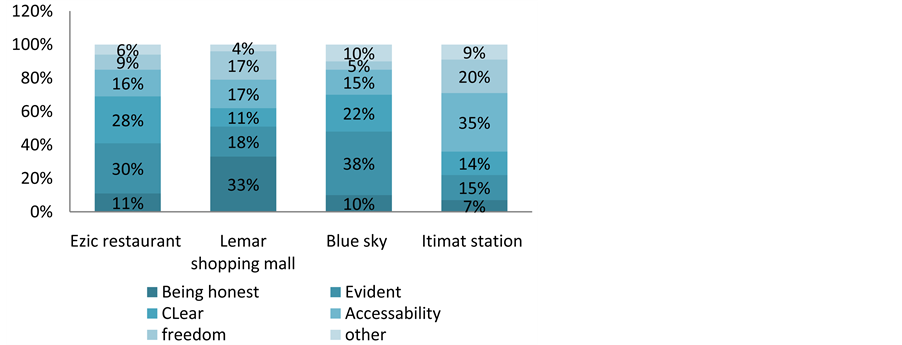Current Urban Studies
Vol.03 No.04(2015), Article ID:61923,17 pages
10.4236/cus.2015.34030
Symbolic Meaning of Transparency in Contemporary Architecture: An Evaluation of Recent Public Buildings in Famagusta
Gelareh Sadeghi1, Rafooneh Mokhtarshahi Sani2, Yuan Wang1
1School of Architecture & Urban Planning, Huazhong University of Science and Technology, Wuhan, China
2Architecture Faculty, Eastern Mediterranean University, Famagusta, Northern Cyprus

Copyright © 2015 by authors and Scientific Research Publishing Inc.
This work is licensed under the Creative Commons Attribution International License (CC BY).


Received 20 November 2015; accepted 13 December 2015; published 16 December 2015

ABSTRACT
The history of transparency in architecture demonstrates a long relationship between glass and architecture. Transparent glass architecture has become one of the significant characteristics of 20th century. It has been one of the materials, which were used extensively in construction; and caused a significant change in the built environment, specifically in the 21st century. Nowadays, glass can be seen as one of the basic materials used in contemporary buildings. The usage of glass in architecture, specifically in public buildings, has increased during the recent few decades, and this trend is still continuing. In addition, Modern architecture has grown rapidly around the world and it has been investigated from various aspects. However, relationship between architectural meaning and modern architecture has been one of the less investigated issues. Therefore, despite the many benefits of transparent architecture, looking for meaning is one of the important factors that need to be investigated. Since search for meaning has been one of the challenging issues for contemporary architecture, the purpose of this study is to find the link between transparent architecture and symbolic meaning in contemporary architecture to recognize how it is possible to bring these two together. To achieve this aim, the research method in this study consists of combination of quantitative and qualitative research methods, besides; literature review has been analyzed based on “content analysis method”. Under this scope, three famous transparent buildings in London have been selected as sample study. To compare and verify symbolic meaning of transparent buildings, in sample study, paper focused on recent transparent buildings in Famagusta. Accordingly, an interesting and arguable finding is that symbolism is interpreted differently by everyone and therefore it is a matter of view point. Although in general transparent architecture is symbol of modernity, but according to user’s viewpoints there is different symbolic meaning for each transparent building. This finding is a proof to this important issue that people need to have meaningful built environment, so they even assign meaning for buildings.
Keywords:
Contemporary Architecture, Transparency, Symbolism, Architectural Meaning, Public Buildings

1. Introduction
Transparency concept has important influence in twentieth-century architectural practice. According to Ascher (2003) , sometimes it is difficult to summarize and categorize the different definitions of transparent architecture because of the wide range and several interpretations of the term transparency (Ascher, 2003) . Sigfried Giedion, among others, has observed that “Transparency is a fundamental quality of artistic production that can be traced back to the origins of art and architecture” (Siegfried, 1962) . In addition, Adrian Forty identified transparency in his dictionary as “key twentieth century architectural term while at the same time acknowledging the tendency to discuss transparency in its material sense rather than its theoretical metaphoric ones” (Forty, 2004) . On the other hand, historically the main role of glass in architecture has been established in respect of light’s transition. Actually, one of Le Corbusier’s major official manifestos was that “architecture is the masterly, correct and magnificent play of masses brought together in light” (Corbusier, 1986) . Light is one of the architecture’s true crude materials. Glass allows the light in as it reflects the light, which is the phenomenon of glass in architecture (Corbusier, 1986) .
Architectural glass concept plays an increasingly important role in contemporary building design. The concept of transparency as an architectural ideal has been well recognized in the history of modernism; also, there are number of overlooked and particular buildings from this time. Using transparent material in architecture is not certainly related to contemporary architecture. The nineteenth century is beginning the era of transparency which oriented towards the glass architecture. In fact, transparency and lightness are two important factors in modern architecture and over the last years, glass has become a main architectural element particularly in the design of contemporary public buildings in many cities around the world (Vidler, 2003) . With this expectrum, some of public buildings, for instance offices, generally became entirely transparent. Also, the other building types followed this concept depend on their functions.
Therefore, now architectural glass is as an integral part of contemporary building’s structure and style, which has grown around the world. Along with this expansion, people need to have meaningfully built environment and building that can be shown through symbols. Symbols are used frequently in every society and are employed to represent something other than what they appear to be. Geertz and some scholars, use the symbol as a veneer term “act, relation, or quality for any object which serves as a vehicle for a conception” (Geertz, 1973) . In addition, according to Kenzo Tange, “There is a powerful need for symbolism, and that means the architecture must have something that appeals to the human heart” (Erman, 2004) . Besides, symbolic meaning has been one of the important aspects of built environment that especially in modern and contemporary architecture has been less investigated. According to Adrian Forty (2004), “the term transparency is widely used within the architectural world and a term we are all familiar with; it’s also a term we rarely seek to analyze for its exact meaning or application” (Forty, 2004) .
The modern style has been used to this day in contemporary architecture. However, that word embodies so many different forms of architecture, in which often symbolic meaning aspect of them has not been considered deeply. One of the main criticisms about modern architecture is that architecture is reduced to a functional and purely utilitarian role. The beautiful art’s lines change their place to the inflexible and cold lines of geometry. This becomes an extremely predominant issue that is debated in today’s architecture. Recently a great extent of criticism of modern architecture’s affirmation on functionalism manifested (Frampton, 1992) .
In view of that, modern architecture has grown rapidly and it has been accepted by all architects around the world, especially for developing countries. Architects have tried to imitate the Modern architectural buildings in the world, without considering the different effects on their cultures and their country. In some new designs, major preference placed on the physical aspects or design itself rather than meaning and symbolism. So, the main dilemma is to find the proper relationship between transparency and symbolic meaning in contemporary architecture. Transparent building can provide both aesthetic and symbolic meaning if designed properly. So, it is important to know how a symbolic transparent building can be created. Obviously, this aim, this endeavoring to become symbolic, is the potential for architecture.
2. Method of Study
In this study, the method is mixture of qualitative and quantitative methodologies, which are literature review, survey, observation and distributing questionnaire. In addition, it is included of analyzing three famous transparent building in London. Accordingly, to obtain result and find key factors, literature review has been analyzed through “content analysis method”, which is one of the qualitative data analyzing methods. In addition, field study is consisted of observations, physical analysis of buildings, visualization in the form of photography and maps. Also, it will be followed by application of a questionnaire through the people and users. Under this scope, sample study approach has been chosen to find the answer of research questions of this study. Accordingly, the four case study’s samples are the examples of transparent buildings, and mainly focused on public buildings in Famagusta. Then, each of those samples is evaluated according to key factors that were derived from literature survey. At the end, conclusions are drawn from the findings of the case studies.
3. Transparency and Modern Architecture
Architectural transparency is understood as building development, the use of open and transparent material, or the combination of form and meaning, is one of the important features of twentieth century building practice (Rowe & Slutzky, 1982) . In order to study transparency in contemporary architecture, it is worthy to study the origin of it, which goes back to the Modern architecture. Throughout history, architecture has changed rapidly around the world, and it varied basing on time and the architect. During the 20th century, architecture has grown universally therefore; architects committed the process of formation of an immense shift. Regarding to a number of architecture scholar’s thoughts, first and foremost, the Modern architecture was stimulated by technological and engineering improvements, and the usage of new materials like iron, steel, concrete, and glass in order to generate new construction techniques, as a stage in the industrial revolution (Frampton, 1992) .
During the age of “new architecture”, 1910s and 1920s, transparency, remarkably, was a signifier of modernity, not only technically but also artistically and ethically (Whiteley, 2003) . Conversely, the issue of transparency in architecture was developed since the late 19th century due to few causes and factors. The technological development of that time by helping to produce large glass sheets was the main support for introduction of the issue of transparency (Vidler, 2003) . According to Forty (2004) , “Ideas concerning transparency are one of the most relevant features of our time” (Forty, 2004) . Under this scope, Modern architecture is frequently identical by openness and transparency, which glass façades only present the aesthetic feature of it. Transparency is not only representative of being spectacular, but also needs connotation to generate symbolic architecture.
4. Meaning in Architecture
Meaning is not possible in architecture without being representational (Cassirer, 1953) . Ernst Cassirer who is the Philosopher of Symbolic forms, in his treatise, “comprehensively classifies man as a symbolic animal who needs to provide meaning to “whatever is given to it”, with the very structure of the human mind constituted to perceive in a symbolic way” (Cassirer, 1953) . Therefore, meaning becomes a fundamental, immanent and necessary requirement of humanity. In order to understand how does a building carry meaning, If one presumes architecture as alteration of social, scientific, ideological, religious or philosophical values into concrete physical forms, then it will make it possible to see the physical forms as mediums of visual communication for human; and to see architecture as a device to connect meanings with human societies. Meaning is a concept that has social ramification. It is a cultural product, which is founded upon historic experiments or historic maturity; impressing established rules of architecture. Some scientific researches show that people always allocate meanings to objects (Krampen, 1979) .
According to Eisenman “an architect should always be able to answer the question ‘Why does this building look like this’? With a nod to historical example or cultural meaning” (Jackson, 2008) . Nowadays, the answer is because it can be produced by the computer, or because of imitations and globalization from other countries. Today, often modern architecture’s focus is increasingly on “spectacular meaning”, architectural building icon with no meaning (Smith & Bugni, 2006) .
Philosophically, there are various theoretical approaches to and levels of concern with the meaning’s concept in architecture. The empirical approach presumes that “meaning has to be assigned to events after the perceiver has registered the structure of the events” (Smith & Bugni, 2006) . Confronting such an introverted analysis in which meanings are given initial priority, another group as Transaction a lists investigates meaning as “a matter of past experience, interrupting, so to speak, perception to give it a new meaning” (Smith & Bugni, 2006) . On the other hand, Gestalt theoreticians assume that “expressive meanings at one level are function of the geometric character of the environment” (Rapoport, 1990a) .
According to Lang (1987) , the data captured from the environment has symbolic features that give it meaning, ambient qualities that draw emotional reactions, and motivational messages that infuse needs. To him, the built environment can be perceived to communicate a diversity of meanings, which are numerously possessed in any artifact or surrounding; from being applied to being symbolic. To know the essence of these symbolic meanings and the way they were developed are very important in order to apprehend the concept of environmental meaning (Lang, 1987) . In addition, Cassirer believed that “while every symbolic form has specific features which are autonomous, there were also the universals which interpenetrated all symbolic forms” (Cassirer, 1953) .
Therefore, architecture should recuperate its ability to express meaning, so the designers are much responsible; they should find a way to create meaningful designs. Obviously, it is necessary for the designer to have valid design criteria, so that the design can reach to its target. In addition, there are various methods to create meaningful designs. Under this scope, symbolism is an option to show the meaning of architecture. It leads us to presuppose of finding the meaning of the contemporary architecture, because the human mind takes “images” from a concept or buildings’ form, and provides them meaning by the symbolic forms of the mind (Smith & Bugni, 2006) . Therefore, the importance and role of architectural forms emerges, in order to create meaningful buildings.
Importance of Form, Function, Meaning
The three important features that definitely form the foundation of all architectural form are Function, Form and Meaning. These features necessarily should be present at all times, although they might have various individual importance. If one of these three is absent, then the mentioned work can simply be taken out from categorization of architectural work (Salura & Fauzy, 2012) .
Apart from clarifying why these three features are considered essential, the diagram (Figure 1) is a description for the relation between the revolving features of Function, Form and Meaning or the process of making them operational under real conditions. According to Salura & Fauzy (2012) , the features of idea and expression are accommodated in each and every form. It can be possible to give concrete shape to expression and ideas if there is a medium or “umbrella” for this purpose. In consequence, every result of architectural design must display function-form-meaning evermore (Salura & Fauzy, 2012) .
Displacing of Function-Form-Meaning in the diagram above shows the process of making its stages operational while their change. “The functional aspect is always affected by its particular cultural and natural context. The formal aspect always contains within it the structure of the construction accommodating the function of zoning. The aspect of Meaning is obtained from the interpretation derived from the actual appearance of form” (Salura & Fauzy, 2012) .
Figure 1. Diagram showing rotation of the aspects form, function, and meaning source: (Salura & Fauzy, 2012).
5. Architecture and Symbolism
The nature and manifestation of a symbol is to represent or reflect something more insightful than its reality ( Mitford, 1996 in Sani, 2009 ). From a critical look, it can be seen that symbolism is found almost everywhere; but contingent on when something represents more than its actual meaning. However, different people, culture, tradition, or custom might view it from a different point of view, although inscribing symbolic meaning into it (Avis, 2005) . According to Hall (1996) , “It seems we have a natural tendency to create symbols in the way we are thinking or in art…” (Hall, 1996) . Therefore, symbol’s usage does not belong to specific era or a certain society. According to Mitford (1996), human is surrounded by ideas, signs, and images, which are frequently very symbolic, apart from the type of their society or community, whether they have not changed by time or commercialized. Since the prehistoric times, signs and symbols have been an essential part of societies and cultures ( Mitford, 1996 in Sani, 2009 ).
After dealing with concept of the symbol, it is time for exploring the course of constituting the symbolic meaning in architecture. The architecture’s value is based on its meaning and trying to minimalize architecture to its construction position would decrease the value of architecture. Hence, the need for meaning is not something fantasy, some buildings are in serious need of it. In the case of modern transparent buildings, symbols are important in terms of achieving the symbolic meanings.
Architecture can play an illustrative role by representing meaning through the built environment. This points out that the buildings are able to represent and connect to socio-cultural traditions or express one's opinions and ideas. Rapoport (1990b) clarified statement, when he declared that “a variety of cultural or symbolic values can be expressed in a building through choices in materials, colors, forms, sizes, furnishings, and landscaping” (Rapoport, 1990b) . Indeed, symbolic characteristics can be seen in every category of buildings, from huge monumental ones to small normal houses. Each type of architecture may have different symbolic qualities, but relatively every building transmits some symbolic messages. According to Erman (2004) , the symbolic performance is defined by symbolic meaning of the user and it is an element of building performance. Therefore, the symbolic meaning arises in the user’s mind, relying on physical quality of the buildings (Erman, 2004) . Symbols give meaning to a plant, object and animal; likewise, symbolism is the practical use of any iconic representation by careening particular conventional meaning (Jarosinski, 2002) . Moreover, human provides meanings to the images that it received from objects and by his symbolic mind. Also, spatial relations between human and buildings are created by means of symbols more than forms; and more than being seen as form, architecture is seen as symbol. Therefore, a modern transparent building’s concept should be inherently symbolic or carry meaning; also its meaning is established by the ideas, images, and feelings, which it rises in the mind of visitors.
In sum, Symbols should rely on profound memories and one’s perception of the spiritual world also, sympathetic with our tradition and origins. This is done by diverse symbolic forms inherent in our mind: through art, religion, history, philosophy, etc. Additionally, a building is nothing less than the symbolic representation of the tradition, values, culture, and creativity levels of the special country in which it stands.
In order to examine the results of literature review, some architectural critiques related to famous transparent contemporary buildings in London has been explored in the following section.
Symbolic Meaning of Contemporary Transparent Buildings in London
In this respect, it is tried to find the world’s most famous contemporary modern transparent buildings. Accordingly, London has been selected as the cradle of modern architecture. Since the century turned, a new type of architecture, mostly using concrete, steel and glass has become an increasingly significant part of the ever- changing cityscape. This transparent modern architecture is a highly visible characteristic of the city and absorbs the attention from all over the world. So, London like any other modern city includes transparent buildings, of which some are widely well known to the world. Following this description, among all London’s public transparent buildings, three most famous and well-criticized buildings (Gherkin Tower, London City Hall, Shard Tower) have been selected to be investigated and analyzed according to their symbolic meanings. These buildings are as key examples of London’s contemporary modern transparent buildings (Tables 1-3).
As a result of analyzing through content analysis method, three factor of “key structural and idea behind the concept”, “deliberately symbolic building (contrasting a building with the aim of having a symbolic building)” and “referring to a universal patterns”, were the most effective factors in creation of symbolic meaning for transparent buildings in London. An important finding is that the famous transparent buildings in London have been constructed at first with the goal of being a symbolic building. To achieve this goal, “form” of building has
Table 1. 30 ST MARY AXE (Gherkin Tower) _ London_ Architect: Foster and Partners_2004).
Table 2. London city hall_London_Architect: Foster and partners_ 2002.
been the most important factor in creation of symbolic meaning in three sample buildings in London (Gherkin Tower, London City Hall, Shard tower). So, these buildings are a kind of symbolic and meaningful architecture. In addition, the architects erected these buildings to show the modernity and to be as a landmark for the city. So, transparent architecture is certainly symbol of modernity. These findings would reinforce the outcome of literature review (Table 4).
Table 3. Shard tower_London_Architect: Renzo piano_2012.
Table 4. Result of literature review based on “content analysis method”.
Figure 2. Gherkin tower.
Figure 3. Perfect egg shape.
Figure 4. London city hall.
Figure 5. London city hall’s spiral walkway.
Figure 6. Assembly chamber.
Figure 7. Shard Tower.
Figure 8. View of tall ship mas.
Figure 9. Pyramid.
6. Field Study: Evaluation of Symbolic Meaning in Contemporary Transparent Buildings of Famagusta
During the 20th century, many cities all around the world transformed radically in accordance with the process of modernization and industrialization. The technological, political, cultural, economic and demographic transformations caused effects that appeared in public built buildings. In other word, one of the most parts of the built environment influenced by changes was public buildings. Famagusta in North Cyprus with its historical image of the city wasn’t an exception. This paper is going to evaluate the significance of symbolic meaning of the modern buildings on some examples, which were selected according to their transparent facades from Famagusta city.
6.1. Brief History of Famagusta
Famagusta is located on the east coast of Cyprus Island on Mediterranean Sea, which is the second large city in North Cyprus; with the population of approximately 6000 and harbor. The city accommodates several remarkable historical monuments, as a part of architectural and cultural heritage of the Island from its long, ironic, unique and turbulent history; including the fortifications that are considered to be one of the most valued ensembles of medieval architecture in the world. New urban developments have been surrounded the historical core of the city, formally or informally as the centuries; and the new layout is drastically different than the traditional layout (Önal, Dağli, & Doratli, 1999) .
In the late 1960, Famagusta became one of the best-known international centers of entertainment and tourism. On the other hand, there were structures that assigning the features of British colonialism; these buildings are reflecting contemporary tendencies in architecture, and they were mostly located in Varosha. In this period, Famagusta’s Architecture reflects a wish to join history and modernism chasing the progress. From its background, as a small harbor in the 7th century, in the 1970s Famagusta had become a town displaying the global tendencies of the modern architectural movement (Önal, Dağli, & Doratli, 1999) .
6.2. Evaluation of Samples
The reason for choosing Famagusta in order to be evaluated is that it has been experiencing radical transformations, mainly, during the recent years. The examples are chosen regarding to their construction date in the city. Moreover, there are only four buildings known as transparent, on the edge of the main street in Famagusta. In this regard, the total number of four transparent modern public building has been analyzed. (Ezic Restaurant, New Lemar supermarket, Itimat Station and Blue Sky Plaza)
These buildings have been constructed in three different periods during the recent 10 years. One of the buildings is the newest branch of Lemar Supermarket, which is constructed very recent (2013). The other building is Ezic restaurant, constructed 2011. Itimat Bus station belongs to the 2009, and finally Blue Sky Plaza, which is constructed 2005.
Accordingly, the research was conducted by distributing questionnaire. Totally 40 questionnaires were done by random selecting local and foreign people who were living in the city. Respondents were consisted of foreigner (17) and local (23) users with the majority of the aged between 20 - 35 years old and almost 60% of them were female. Afterwards, data collection started by observations, recorded by photography, in order to analyze the transparency and architectural meaning in forenamed buildings because of their special facades. The aim is to evaluate the problems of symbolic meaning in this kind of transparent buildings to find a connection between the transparent architecture and symbolism. Consequently, the results of literature review, which obtained based on “content analysis method”, have been applied in four sample study buildings.
6.2.1. Ezic Restaurant
Ezic Restaurant is the newest one among all the restaurants in Famagusta. Observations about Ezic restaurant in Famagusta illustrate that this building emphasizes form and it has a transparent façade. In more area it is covered by glass and it has created a modern façade for the building. This building has simple curved plan and façade rather than ridge and furrow, with the glass draped over the steel frames. The use of covered glass to terminate the elevation is a powerful and typical expressionist image. In addition, there is a strong relation between outdoor and indoor spaces. Also, its transparent façade allows a better view to outside. For this kind of transparent facades with large scale of glass that window is wall itself and wall is window itself, it is difficult to understand the difference between inside and outside of the building especially at night that facade shows the entire interior space of this restaurant (Figure 10).
A Transparent façade can make a building more attractive and more welcoming to customers. The restaurant is not built exactly at the edge of the street; there is distance between street and building. However, when you pass from this part of the street it comes to your eyes and can act as a focal point of that area and it is visible from the main street. It is also envisaged as a special, memorable and symbolic building of the arrival in Famagusta. The building combines symbolic architecture with interesting, functional features.
6.2.2. New Lemar Supermarket
New Lemar supermarket was constructed 2012. This shopping mall is located on Salamis street in Famagusta (Figure 11). It is the newest constructed public building in the city, also the largest supermarket. The style and method of design and construction of building shows that glass has been major material in the concept of the structure, and it has been beautifully used. It is a massive building, with a linear plan created by angular forms with straight lines. Moreover, the total façade of the building is covered by glass, which gives its impact on beautiful landscape. It is a fine example of modern architecture, outstanding within its mostly traditional neighborhood. The fully glazed cover of the building lets the users enjoy better external consciousness; moreover, it benefits from the daylight. Accordingly, this building is symbol of modernity, economic growth and technology of the city.
6.2.3. Blue Sky Plaza Building
Blue Sky Plaza is located in Salamis street in Famagusta (Figure 12). The interior design gives flexibility to
Figure 10. Famagusta, Ezic restaurant.
Figure 11. New supermarket.
Figure 12. Famagusta, blue sky plaza.
change the rooms according to the usage. Today several offices and shops are placed inside this building. The building with its rectilinear shapes and straight lines, which is entirely covered by glass is clearly influenced by modernist tendencies.
6.2.4. Itimat Station
This building is constructed at the edge of the main street (Figure 13). It is the only bus station in Famagusta city. Itimat station has curvilinear form, which is not a huge building and its façade entirely covered by reflex glass, so inside of the building is not visible from the outside.
6.3. Analysis of Questionnaire Result
The purpose of this question (Figure 14) is to understand the value and role of glass and transparent facades as a sign of modernity of buildings. According to the bar chart, 85% positive answer confirms that transparency and usage of glass in buildings is an obvious sign of modernity.
Figure 13. Famagusta, Itimat station.
Figure 14. Transparency as a sign of modernity.
According to the users view points, this general question (Figure 15) was aimed at finding out the importance of form and meaning, also their relationship in design of modern buildings. It is apparent from the bar chart more than 67 percent of the peoples preferred form and only 33 percent of them were agree with the importance of meaning in design of modern buildings. Form and meaning are two important poles of architectural design. There is a strong relationship between them for modern buildings. But, for people form of the buildings has special value, so one of the important aspects of modern architecture which is meaning is often missing.
As it has been shown in the bar chart (Figure 16), most of the people are approve of the importance of symbolic meaning in architecture (77%). It can be said that most favoured more symbolic and meaningful buildings. In comparison with the result of last question, it depict that peoples are interested in both special and aesthetic also meaningful architectural forms. So, it is important to create a balance between form and meaning in design of modern buildings.
According to this diagram (Figure 17), the highest percentage (72%) is related to Lemar supermarket, which is the newest and more attractive transparent building for people. So it can force them to think about the symbolic meaning of the building. Accordingly, time is important too. It means recent buildings are more important to design symbolic. The second highest percentage (67%) is related to Ezic restaurant, because of its unique architectural form, which has significant role on attraction of peoples. Importance of both form and meaning can be understandable, especially for transparent buildings, which they have strong ability to attract peoples. It can be said, there is a strong relationship between meaning with unique form of architecture and time of construction.
The diagram (Figure 18) illustrates that there were differences in the perception of symbolic meaning between people. In addition, in compare those together, the highest percentage is related to Ezic restaurant and second highest percentage is related to the Lemar supermarket, which are as two landmark and famous glass buildings of Famagusta. According to the 60% positive votes about the symbolic meaning of Ezic transparent building, the focal point of the result is that symbolic meaning of a transparent building is not just related to the extensive usage of glass in facade. There are other basic important factors too, which is related to concept of architectural design.
Figure 15. Importance of form and meaning in design of modern buildings.
Figure 16. Importance of symbolic meaning to be a kind of language for architecture.
Figure 17. Importance of transparent building’s meaning for users, also their attention to the meaning of these transparent buildings as a viewer.
Figure 18. Investigation of the value of these buildings according to their symbolic meaning and people’s perception of symbolism (Based to the user’s viewpoints).
According to the diagram (Figure 19); the factor of “According to the architectural form” with 55% vote is realized as the most important factor in designing symbolic transparent buildings. The second most influential factor (30%) is “based on universal patterns”. The result is showing the continuation of importance of form in designing symbolic buildings; also referring to experiences is noticeable in defining symbolic meaning for a transparent building.
This question (Figure 20) was aimed at finding out the way in which the peoples perceived the symbolic meaning of the transparent buildings. The answers of the customers showed that there were differences in the perception of symbolism between individuals. It can be said, there is a strong relationship between understandings of symbolism in people with diverse function of the transparent buildings. In addition, it is very depends on the people view point’s and idea. Also, as it can be seen in the above diagram and according to the user’s view point, “Evident, clear, being honest,” choices are the most frequent answers between other. So, it can be said these are as symbolic meaning of transparent buildings.
7. Result and Discussion
To verify findings of literature review, four transparent buildings in Famagusta have been analyzed. Based on the obtained results from the literature review and analysis the buildings, Ezic restaurant by gaining more credits by people can stand as a highly symbolic transparent building comparing to the other transparent buildings in the city. This finding comes from its “unique form and function”, also “importance of concept of architectural design”, such as “special lighting” and “interior design” and etc. In addition, the second symbolic transparent building in Famagusta is New Lemar super market, which is the “biggest and newest’ transparent building in the city”.
Under this scope, to comparing Ezic restaurant and New Lemar supermarket, the most important result is that symbolic meaning of a transparent building is not just related to the extensive usage of glass in facade. In addition, Ezic restaurant with smaller glass façade has more symbolic meaning than Lemar. This finding can appear as contradiction between these results. Accordingly, the most important point is that designing a modern building with a huge glass façade is not the most valuable factor to create a symbolic transparent building. There are
Figure 19. Important and effective factors on user’s perception of symbolic meaning of transparent buildings.
Figure 20. Symbolic meaning of these transparent buildings (Based to the user’s viewpoints).
other basic important factors, too. Such as, Form, Function, lighting, material, interior design. Furthermore, how to use glass and how to create a great architectural building is the most noticeable factor. So, “Form” and “concept of architectural design”, played the most important roles in people choices of symbolic buildings in sample transparent buildings in Famagusta. Factor of “Time” is noticeable too, which means recent transparent buildings are more attractive in terms of implying symbolic meaning for people. Also, Form has a fundamental role in defining symbolism and giving meaning to buildings. In addition, the importance of function cannot be ignored, however in defining symbolic meaning, it is not as strong as form of architecture. This finding would reinforce the outcome of literature review.
8. Conclusion
In conclusion, beside the architectural developments over the world, people need to have meaningfully built environment and building. Accordingly, architectural meaning can be shown through symbols, also form has a fundamental role to invest meaning to architecture. Indeed, symbolism is a very broad and complex issue, and it can be found almost everywhere. It depends on many factors, so there is no single expression of symbolism. In fact, “symbolism” could be seen as a system of ideas, which is effective in the people’s interpretation of different things such as architectural buildings.
In addition, According to the content of previous chapters of literature review and comparing with the result of questionnaire, architecture and symbolic meanings are based on so many factors, such as “form of the buildings”, “Idea behind the concept”, “universal patterns”, “past experiences”, “functional aspects”, “context”, and “user’s viewpoints”, which affect on impression of architecture. These factors are changeable from time to time. They were different for diverse types of buildings, different people, and various times.
Briefly, it is reasonable to conclude that there is difference between people, builders and architects in viewing architecture. Although in general transparent architecture is symbol of modernity, but according to user’s viewpoints there is different symbolic meaning for each transparent building. Accordingly, this finding is another proof to this important issue that people need to have meaningful built environment, so they even assign meaning for buildings. Based on all of these findings, it is possible to put the concept of meaning forward as an essential aspect of architecture. However, creating transparent architecture that is not able to associate to the users should be considered as construction and not architecture. Therefore, the essential duty of architects is to design for meanings, sine people need to assign meaning to their buildings.
As a direction for future research, this study was limited to a small city in transition from traditional to modern life. However, such kind of researches can be followed in future by studying similar cities and settlements in various cultures to see what transparency can symbolically represent for those societies.
Cite this paper
GelarehSadeghi,Rafooneh MokhtarshahiSani,YuanWang, (2015) Symbolic Meaning of Transparency in Contemporary Architecture: An Evaluation of Recent Public Buildings in Famagusta. Current Urban Studies,03,385-401. doi: 10.4236/cus.2015.34030
References
- 1. Ascher, B. D. (2003). Transparency—A Brief Introduction. Journal of Architectural Education, 56, 3-5. http://www.tandfonline.com/doi/abs/10.1162/104648803321672898?journalCode=rjae20 http://dx.doi.org/10.1162/104648803321672898
- 2. Avis, P. (2005). God and the Creative Imagination, Metaphor, Symbol and Myth in Religion and Theology. London and New York: Routledge.
- 3. Cassirer, E. (1953). The Philosophy of Symbolic Forms. New Haven, CT: Yale University Press.
- 4. Corbusier, L. (1986). Mass-Production Houses. In L. E. Corbusier (Ed.), Towards a New Architecture (pp. 229-265). New York: Dover Publications.
- 5. Douglas, L. (2011). The Shard—Europe’s Tallest Building. Engineering and Technology Magazine, 6, No. 9. http://eandt.theiet.org/magazine/2011/09/vertical-city.cfm
- 6. Erman, O. K. (2004). The Analysis of Symbolic Performance in Mass Housing Settlements. Journal of Building and Environment, 39, 449-457.http://www.sciencedirect.com/science/article/pii/S0360132303002178 http://dx.doi.org/10.1016/j.buildenv.2003.09.006
- 7. Forty, A. (2004). Words and Buildings: A Vocabulary of Modern Architecture. London: Thames & Hudson.
- 8. Frampton, K. (1992). Modern Architecture: A Critical History (3 Sub ed.). New York: Thames & Hudson.
- 9. Freiberger, M. (2007). Perfect Buildings: The Maths of Modern Architecture. Plus Magazine. http://plus.maths.org/issue42/features/foster/index.html
- 10. Geertz, C. (1973). The Interpretation of Cultures. New York: Basic.
- 11. Hall, J. (1996). Illustrated Dictionary of Symbols in Eastern and Western Art. New York: Icon Editions.
- 12. Hyatt, P. (2004). Great Glass Buildings: 50 Modern Classics. Mulgrave, Vic.: Images Pub.
- 13. Jackson, N. (2008). Architecture in the Age of Media: Eisenman’s Strong Six-Point Plan. http://blogs.britannica.com/2008/05/architecture-in-the-age-of-media-eisenmans-strange-six-point-plan/
- 14. Jarosinski, E. (2002). Architectural Symbolism and the Rhetoric of Transparency: A Berlin Ghost Story. Journal of Urban History, 3, 223-242. http://juh.sagepub.com/content/29/1/62.extract http://dx.doi.org/10.1177/009614402237573
- 15. Knöfe, U. (2012). “The Shard”: The Building That Will Change London Forever. http://www.spiegel.de/international/europe/the-shard-the-building-that-will-change-london-forever-a-806785.html
- 16. Krampen, M. (1979). Meaning in Urban Environment. London: Pion.
- 17. Lang, J. (1987). Creating the Architectural Theory. New York: Van Nostrand Reinhold Company.
- 18. Marmot, A. (2004). City Hall, London: Evaluating an Icon. Proceeding of the Conference “Closing the Loop: Post-Occupancy Evaluation: The Next Steps”, Windsor, 29 April-2 May 2004, 1-27.
- 19. Mitford, B. M. (1996). The Illustrated Book of Signs and Symbols. London: Dorling Kindersley.
- 20. Önal, S., Dagli, U., & Doratli, N. (1999). The Urban Problems of Gazimagusa (Famagusta) and Proposals for the Future. Cities, 16, 333-351. http://www.sciencedirect.com/science/article/pii/S0264275199000311
- 21. Powell, K., & Grant, S. (2006). 30 St Mary Axe: A Tower for London. London: Merrell.
- 22. Rapoport, A. (1990 a). Symbolism and Environmental Design. International Journal of Symbology, 1, 1-9.
- 23. Rapoport, A. (1990 b). The Meaning of the Built Environment: A Nonverbal Communication Approach. Tucson: University of Arizona Press.
- 24. Rowe, C., & Slutzky, R. (1982). Transparency: Literal and Phenomenal. Cambridge, MA: MIT Press.
- 25. Salura, P., & Fauzi, B. (2012). The Ever-Rotating Aspects of Function-Form-Meaning in Architecture. Journal of Basic and Applied Scientific Research, 2, 7086-7090. http://www.purnamasalura.com/uploads/3/2/0/3/32036609/ffm.pdf
- 26. Sani, R. M. (2009). An Inquiry into Iranian Architecture Manifestation of Identity, Symbolism, and Power in the Safavid’s Public Buildings. PhD Thesis, Gazimagusa, North Cyprus: Eastern Mediterranean University. http://i-rep.emu.edu.tr:8080/jspui/handle/11129/86
- 27. Sellar, I. (2012). An Introduction to London Bridge Quarter. http://www.1londonbridgesquare.co.uk/media/36765/london_bridge_quarter_brochure_lr.pdf
- 28. Siegfried, G. (1962). The Eternal Present, Volume 1: The Beginnings of Art. New York: Pantheon.
- 29. Smith, R. W., & Bugni, V. (2006). Symbolic Interaction Theory and Architecture. Journal of Symbolic Interaction, 29, 123-158. http://dx.doi.org/10.1525/si.2006.29.2.123
- 30. Vidler, A. (2003). Transparency and Architecture. Journal of Architectural Education, 56, 3-39.
- 31. Whiteley, N. (2003). Intensity of Scrutiny and a Good Eyeful: Architecture and Transparency. Journal of Architectural Education, 56, 8-16. http://www.tandfonline.com/doi/abs/10.1162/104648803321672915 http://dx.doi.org/10.1162/104648803321672915


